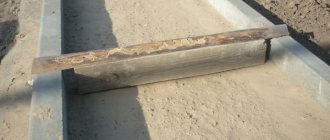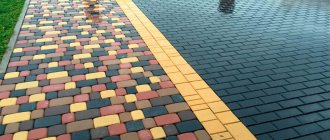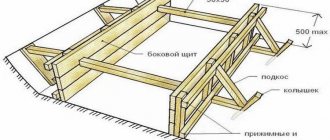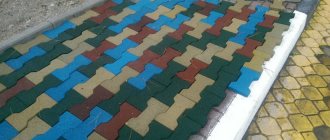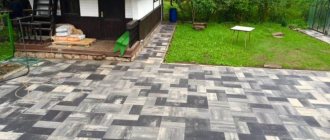To keep the yard clean and beautiful in any weather, the owners cover the garden paths and recreation area with various materials. Paving slabs are well suited for these purposes. Various patterns of its installation allow you to simulate space and create interesting patterns. But it should be understood that the visual effect of decorating the local area will depend on the chosen scheme for laying paving slabs.
The material has high decorative and artistic properties. This allows you to create different color and light-and-shadow solutions, opening up wide possibilities for creativity.
How to choose the right paving slab laying scheme
Beautiful and aesthetic paving is created as a result of painstaking work and well-thought-out site planning. In addition to the imagination and wishes of the owners, the choice of paving scheme is influenced by:
- landscape features;
- site architecture;
- place of installation and its purpose;
- dimensions and configuration of the site.
Street tiles for paths are used as one of the elements of landscape design. This is an exclusively design product: the installation pattern affects the visual perception of the coating. With its help you can model space. Paving slabs are a durable material. Therefore, the choice of installation scheme must be approached carefully.
This article will tell you what plastic tiles for paths in the country are.
Features of choosing patterns and layout of paving stones
Paving of areas is done for parking or for recreation areas. Depending on the purpose of the site, the paving method and tile sizes are chosen. For the courtyard, classic rectangular tiles are often used. Original patterns are obtained by alternating tiles of different colors at the right angle and using a specific pattern.
All information about the texture of paving slabs is presented at this link.
Types: square, classic, chess, diamond
Curly types of tile layouts make it possible to create even more interesting designs. Sites using textured tiles look impressive. But for beginners without experience, it is better to opt for easier types of paving. It is not recommended to undertake laying tiles such as “rhombus”, “brick” and “paving stones”. They are the most difficult to install; even masters are engaged in paving these types for a higher price. In this case, sites should be chosen with the correct geometric shapes. In this case, you can minimize, or even avoid, cutting off the protruding parts of the tiles.
The most popular pavement layout schemes:
- "linear-angular";
- “linear with shift”;
- "classical";
- "modular";
- diamond;
- circle;
- "parquet";
- "chess".
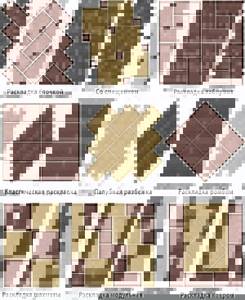
The most cost-effective are modular and linear with shift schemes. This is due to the ease of installation and minimal trimming of edge elements.
What is the best laying pattern for garden paths?
Paths decorated with paving slabs are pleasing to the eye and enliven the appearance of the yard and garden. The central path is often made straight. Narrow paths leading into the garden do not necessarily need to be designed as straight. Paving slabs allow you to create coatings of different configurations.
Garden path paving scheme
The curved shape of the paths looks more natural and interesting. It visually expands the space, making it more voluminous and multifaceted. For classic-style paths, the following paving schemes are used:
- “herringbone” (achieved by laying tiles at an angle of 90 or 45°);
- “braid” (created by alternating longitudinal and transverse tiles);
- “chess” (tiles of two colors are laid in a checkerboard pattern).
We also recommend that you familiarize yourself with the features of molds for making garden paths.
These patterns are suitable for paving paths with rectangular and shaped tiles. On paths with curves, a “brick bond” laying is used. It allows you to create soft curves and smooth out small corners.
Visual perception of paved paths
The direction of the rows of tiles being laid affects the visual perception of paved paths. Taking into account some points, you can place emphasis on the site:
- In order for the path to be visually perceived as shorter, the rows are laid perpendicular to the direction of movement.
- The coincidence of the direction of the laying rows with the axis of the track contributes to the optical stretching of the object.
- Herringbone paving, made at an angle of 45°, visually compresses the space.
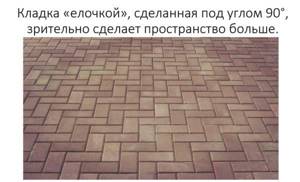
- Even, parallel rows of rectangular bricks also work well in small areas. Although they can be successfully used on large areas.
- To create perspective, rows of bricks placed on their ends are used. It can be bent into a circle and is often used as path edging.
Paving slabs as a means of decorating the yard and garden
The scheme for laying paving slabs can be either very simple, when two colors are combined in a certain order, or complex, with the help of which you can create real designs.
For paving your yard or garden path, you can choose classic rectangular tiles. Despite the fact that its shape is simple, rectangles of different colors can be successfully combined to form an interesting pattern. When choosing figured tiles, the path will look even more original.
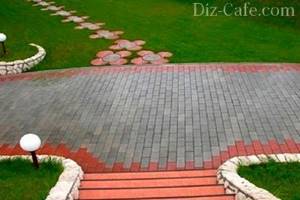
The cute path is created using gray brick tiles and edging the sides of the path with red tiles. A matching staircase and a path made of decorative saw cuts in the shape of flowers add completeness to this part of the garden.
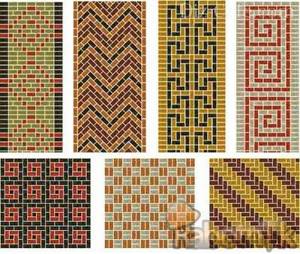
Various designs on paving slabs are created using color, shape and alternating tiles according to a specific pattern.
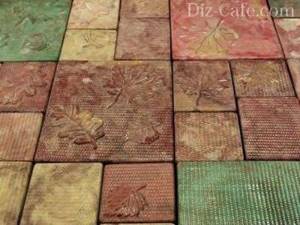
Textured tiles are a good option for the garden, allowing you to create original patterns and combinations. Its color can harmonize with the color of the soil and the greenery of lawns. In this case, the pattern of leaves on the surface is appropriate in the garden
Herringbone and wicker
Popular patterns for laying paving slabs include herringbone and wicker. The herringbone pattern can be obtained by laying tiles at a certain angle - 90° or 45°. Braid is a version of herringbone, when the alternation of tiles resembles interlacing. The braid is created by alternating longitudinal and transverse laying.
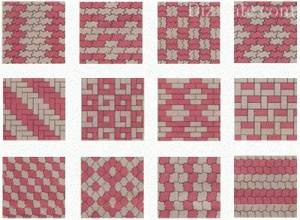
Simple drawings for creating patterns on rectangular and shaped paving slabs. To create a striking pattern, you can use only two colors. In the first row in the second illustration there is a herringbone, in the fourth row in the second illustration there is a wicker
DIY installation options
Experienced craftsmen can use several paving schemes on one site. They easily combine colors and shapes, create curves and achieve interesting effects. Different types of paving slabs provide different patterns for how to lay them.
Basic patterns with beautiful patterns
For paving paths and areas with your own hands, it is better to use simple laying schemes. Let's look at some of them in more detail.
"Herringbone" and "Braid"
These types of styling are used most often. They do not require highly skilled craftsmen when installing, but are able to create attractive patterns. Braid is one of the herringbone options. In this case, the rows alternate between longitudinal and transverse laying.
"Round"
The scheme has found application on round platforms. The circular pattern allows you to create beautiful seating areas, especially when combined with other patterns such as shuffle or herringbone.
Classic way
The classic method is based on the use of shaped tile elements of several shapes. Usually these are rectangles. The scheme fits well with a minimalist or classic landscape style. The “Parquet” and “Brick” schemes are also called classics. Coatings using tiles of different colors look beautiful.
Retro style
This “Old Town” option is reminiscent of the streets of ancient or retro cities. For paving, tiles of three or four different sizes, shapes and shades are used.
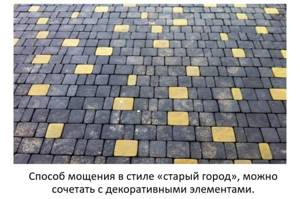
Popular layout schemes
There are many options for laying brick paving slabs. The installation process is facilitated by diagrams developed by specialists. Using them, even non-professionals can lay tiles efficiently. All installation options can be divided into 3 categories.
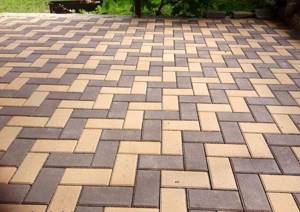
The first includes options when only 1 color tile is used. They are the easiest to implement. The second category includes options that use paving stones of 2 or more colors. This is a more complex installation method.
The third category includes radius patterns. This installation is difficult to perform and often requires cutting a large number of additional elements, which increases material consumption.
Plain
The simplest option is the linear installation of masonry. In this case, all the bricks with the long side should be oriented along the line of the path. The seams must match. With this type of masonry, it is important to properly arrange and secure the borders. They will hold the paving stones.
In addition, you can lay the tiles in a brickwork pattern. In this case, the direction of the paving stones is maintained, but an offset of ½ tile in adjacent rows is added.
In addition, brick tiles can be laid in a herringbone pattern. In this case, each element is laid at right angles to each other. This is a fairly simple option. The orientation of the Christmas tree can be either along the path or directed towards its side.
The block paving option looks beautiful, in which 2 tiles are adjacent to each other with their long sides, and another 1 element is located perpendicularly. The orientation of such an ornament can be any.
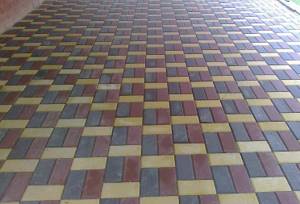
Two or more colors
The simplest version of two-color masonry is “chessboard”. In this case, blocks consisting of 2 tiles are laid out sequentially. In this case, it is important to ensure that tiles of the same color are turned lengthwise in one direction, and tiles of another color in the other direction. This way, the seams will be better visible, which will create the desired effect.
When covering large areas, paving stones can be laid out to create a pattern. The design can be of any complexity and include more than 3 colors of material. To obtain a high-quality result, it is important to make a drawing of the location of the tiles in advance and calculate the dimensions of the pattern on the ground.
Radius patterns
Radius patterns are the most difficult to execute, so if you don’t have the skills to create them, it’s better to choose an easier option. In this case, if you plan to lay a winding path, first lay the first row along its entire length. The orientation of the paving stones should be along the path. The second row begins with a square additional element. This will create a shift that resembles a brickwork pattern. This fills the entire surface of the track.
In addition, moving from a small radius to a large one, you can lay the tiles in semicircles. It is recommended to use elements of different colors. Before starting masonry, you must make a drawing of the design and calculate the amount of material required.
What's the best way to lay it down?
Modern manufacturers offer a range of paving slabs that gives scope for creative imagination. To solve various design problems, all possible installation schemes are used. Some patterns can be used either on their own or, if space allows, easily incorporated into another pattern. Even the most daring ideas can now be brought to life, which makes it possible to lay tiles in any garden area.
"Rhombus"
There are more than 40 types of tiles with this geometry. A variety of colors, textures, shapes and installation combinations allows you to create coatings with a 3-D effect (3D).
Once you become familiar with the principles of laying diamond-shaped elements, you can come up with your own paving options.
- Hexagons . To form patterns, use tiles of one or more colors. The visual effect is achieved through rhythmic repetitions of the selected pattern report and selection of tile colors. The laying pattern can be diagonal or straight. You may also be interested in the features of rubber coatings for paths in the garden.
- Flower (snowflake, star). Usually take three contrasting colors. The pattern can be laid out vertically and horizontally. Before installation, you need to mark the center of symmetry. This is especially true for paths up to 1.50 meters wide.
- Hex star . The pattern is repeated vertically, ideal for paths. You can use two or three colors of tiles. The pattern may consist of a central star with repeating elements or rhythmically repeating star modules.
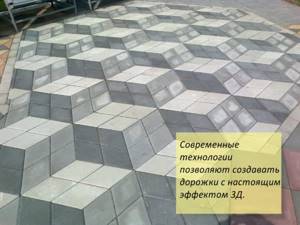
"Wave"
Rectangles with wavy edges look good laid out in the form:
- horizontal or vertical “chess”;
- diagonals;
- brickwork.
These are universal tiles that can make any area attractive. It has an increased contact area on the sides. This helps create a uniform load over the entire surface.
Find out how to lay paving slabs on a concrete base here.
"Clover"
The unusual shape of this Clover tile allows you to create interesting coating options. It can be smooth or rough. Combinations of different colors, textures and sizes of tiles allow you to create aesthetically pleasing coatings.
Even a simple “chess” pattern with such tiles looks impressive. This type of tile is universal in its application.
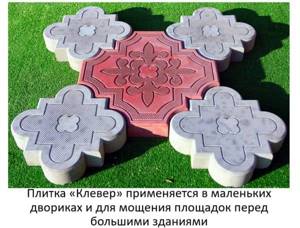
Rectangular
The shape is used to create classic parquet and herringbone patterns. Square tiles are more suitable for checkerboard paving.
Read about how to make a birdhouse with your own hands here.
Brick (brick) or square shapes
Elements of the Brick shape have rounded edges and have proven themselves in such patterns as:
- linear laying without shift or with shift;
- spiral laying;
- modular installation.
How to lay Aurika tiles
The tile follows the texture of crushed stone, has a wide color palette and is available in three different sizes. Aurika slabs are quite large and allow you to quickly create paved areas.
A pattern of large and small squares can enliven even the most boring landscape. For installation, schemes such as:
- "chess";
- "random mixture";
- "Old city".
The technology for laying paving stones is described in detail in this material.
Features of laying tiles: main methods and options
Laying elements of paving slabs requires strict adherence to the technology of working with this type of material.
The simplest and most popular installation options include herringbone and checkerboard patterns, as well as braided patterns.
Circular laying of elements and creating a chaotic pattern based on them is more complex in execution, but at the same time an original way of decorating a local area.
Checkerboard
For this installation method, square paving cladding elements of two different, usually contrasting, colors are used. The method of laying construction and finishing materials can vary:
- when independently laying elements with dimensions V30G-30 cm; installation on cement mortar is optimal;
- when independently laying paving slabs with dimensions V50G-50 cm, the optimal method is the classic method of installation on a sand-concrete base;
- When independently laying elements of facing slabs with dimensions of 40G-40 cm, installation on a sandy base is optimal.
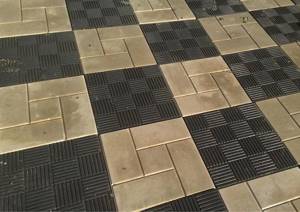
Checkerboard tiles
When choosing a base for installation of a coating, it is necessary to take into account the level of expected load during operation.
Installation of street tiles in a checkerboard pattern can be carried out using square and rectangular elements. The second option allows you to get symmetrical squares when laid in pairs.
"Herringbone"
A fairly simple installation method that allows you to create a coating with an original appearance. Laying paving street tiles in a herringbone pattern involves placing the elements at a strictly defined angle. As a rule, installation of elements is carried out at an angle of B45o or 90o.
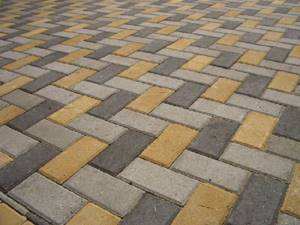
“Herringbone” installation method
In recent years, herringbone paving has been the most popular option for laying paving elements on any straight sections. The “herringbone” look, made using paving slabs of two or more contrasting colors, looks very interesting and original.
Laying tiles using the herringbone method is not difficult, and the resulting surface can withstand quite heavy loads, so this method is optimal in areas with high traffic.
With imitation weaving
The installation scheme for elements of paving stones with a “braided pattern” is one of the main or so-called classic options for paving areas and paths.
This paving option is intended for laying multi-colored or single-color tile elements on limited area and fairly flat square-shaped areas. The “braided” paving slab laying scheme is based on pairwise laying of tiles and allows you to obtain not only a reliable, but also an outwardly attractive coating.
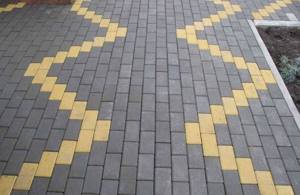
Laying tiles with a braided pattern
To create a “braid” along the entire perimeter of the area marked and cleared of debris or plants, two elements of paving slabs are laid in a side position. Each subsequent pair of elements must be laid in such a way that the resulting central line is located in the upward direction. The third pair of tile elements should be laid in the same way as the first pair, and the fourth pair in the same way as the second pair, and so on.
Imitation of the original weaving pattern when installing a covering based on paving slabs is achieved by alternating longitudinal and transverse laying of tile elements.
Paving slabs can be laid both on sand and concrete. Laying paving slabs on a concrete base - paving technology.
The technological process for manufacturing paving slabs is described at the link.
You will learn how paths are paved with paving slabs in this article.
Round
Non-standard paving patterns include laying paving slabs in a circle, or the so-called “circular pattern”. In this case, a wedge-shaped design or the “Classico” system is used, which allows you to independently create a unique decorative path or platform with an original coating.
To obtain beautiful and durable circles, the paving base is carefully leveled. It looks very impressive to lay out only some of the circles, which are alternately adjacent to the opposite sides of the mounted track. As a rule, between such semicircles, paving stones are laid out in any linear pattern.
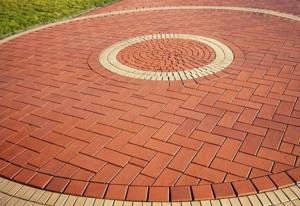
Tiles in a circle
The technology for self-circular paving is quite accessible and not particularly complicated:
- production of rack and pinion compasses of the required sizes;
- marking the circle directly on the sandy base prepared for laying;
- laying paving stone elements in the longitudinal direction relative to the drawn circle, gradually moving inward and reducing the size of the drawn circle.
In a similar way, paving slabs are installed in the form of any other shapes with smooth lines. At the final stage, the paved surface is densely covered with sand, which will fill the space of all the seams. Then the surface is generously watered.
The tiled circular pattern obtained using multi-colored paving stone elements looks very original.
With the creation of a chaotic pattern
The “random mixture” scheme is an original version represented by a chaotic pattern. With this method, there is a great opportunity to bring fantasy solutions to life, as well as get an original and stylish street covering. You need to lay the tiled elements away from you, moving along the laid surface, which will not allow you to disturb the leveled sand base.
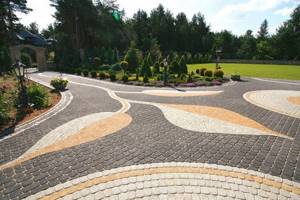
Paving slab pattern
First, solid elements are laid, and adjustment and trimming of the tiles is carried out only after all work has been completed on the main body of the coating. The first or starting row must be mounted along a cord stretched over the sections of the tile bevel. Periodic monitoring of the level of laid tiles is carried out using a bar.
All elements that enter above the general level of the coating are tapped with a rubber mallet, and the mixture must be added to areas where the base noticeably sags.
The most popular types of paving slabs are described in the article: types of paving slabs, pros and cons.
The principle of making paving slabs with your own hands is described in detail here.
Diamond paving
Diamond-shaped paving stones are used to create a variety of paving options:
- Laying hexagons is used to form a pattern based on paving slabs of one or several colors at once. Visualization of the effect is achieved through rhythmic repetition of the pattern and competent selection of tile colors. As a standard, diagonal paving or direct installation of elements is used.
- Laying a “snowflake” or “star” pattern is usually done using paving stones of three contrasting colors at once. In this case, the pattern is laid out both vertically and horizontally. Before installation, the central part of symmetry must be outlined. This pattern is perfect for decorating paths whose width does not exceed one and a half meters.
- Laying a hexagonal star with a vertically repeating pattern is optimal for paving house paths and involves the use of elements of two or three colors. As a rule, the pattern of laying paving slabs is represented by a central star and repeating elements, as well as repeating star modules.
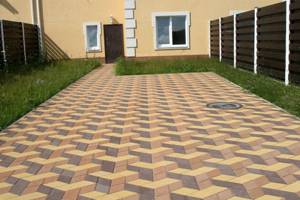
Rhombus paving slabs – photo
More than 35 types of paving slabs with diamond-shaped geometry are produced, and the variety of colors, textures, shapes and paving combinations helps to create a beautiful coating with a 3D effect.
Video: laying out a two-color sidewalk
The video shows how to lay paving slabs with your own hands:
Options consisting of two colors
Color can be used to limit or emphasize one or another area of the site. The most popular colors are neutral gray and all shades of brown. They can be used solo or combined with other colors. Neutral colors contrast well with black, red, yellow, or even green or blue. But keep in mind that colored tiles are more expensive than gray ones.
If you decide to use tiles of different shapes and colors, you need to carefully calculate the consumption of materials and think about combining them with each other. Do not overuse different colors. Two or three shades will be enough. Colorful patterns can create imbalance in a well-thought-out design.
Not only the aesthetic impression, but also the labor intensity of the process depends on the tile laying pattern. A simple pattern made with the popular wave, paving stone or diamond tiles is completed much faster than a complex design solution. In addition, to create an intricate design, it is necessary to cut a significant amount of material, and this will increase its consumption. Maybe
Types of paving slabs
The most popular FEM element (shaped paving elements) is paving stones of the following shapes:
- “brick” (pavement) – format 7 x 14 cm, thickness 8 cm;
Hexagon paving slabs.
Turtle paving slabs.
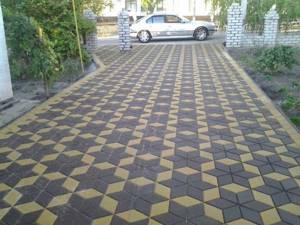
Paving element "rhombus".
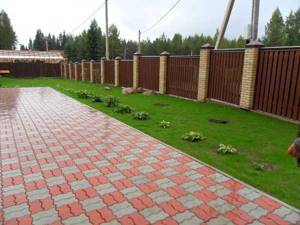
Paving slabs "wave".
“scales” - there are three modifications.
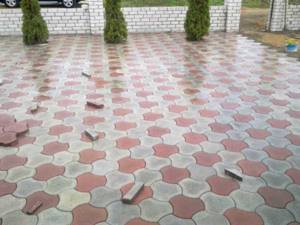
One of the varieties of “scales”.
The last version of the tile is the only one that ensures the creation of a 3D pattern (three-dimensional picture) at minimal cost without additional cutting. To do this, you will need to buy samples of three colors and arrange them as in the bottom photo of the design.
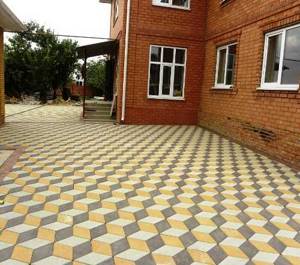
Scheme for laying paving slabs “rhombus” with a 3D effect.
For the home craftsman, examples of paving straight sections with “wave”, “brick” and “clover”, respectively, are also given.
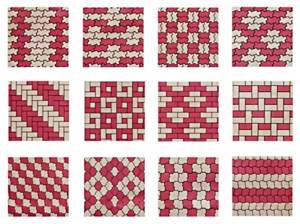
Ready-made methods for “wave”, “brick” and “clover”.
There are many more types of paving slabs than listed above; only the most common varieties are listed here.
What determines the patterns of paving slabs
The popularity of paving slabs among landscape designers and homeowners is extremely high. With its help, you can create a beautiful landscaped area around your house or cottage. Owners of shops and cafes use paving slabs for summer areas and parking lots. It is indispensable when constructing pedestrian paths in parks and alleys. A beautiful pattern of paving slabs can become a real decoration of any space.
In the manufacture of paving slabs, two different methods are used - vibration casting and vibration pressing. The technical characteristics of the finished tiles, as well as the variety of shapes and patterns, depend on which of them is the basis of production. The main components in the production of paving slabs are cement and sand. Dyes allow you to obtain a rich color palette, and various additives make the tiles more durable and flexible. Thanks to this, paving slabs, the types of patterns of which cannot be counted, have truly become the No. 1 material for decorating paths and areas for various purposes.
When choosing paving slabs, you should proceed from the area of its planned application. After all, the requirements for its technical characteristics depend on the purpose for which paving slabs are purchased.
For car parking, where the load on the paving will be significant, tiles with higher strength ratings are required. It is better to give preference to vibropressed paving slabs of maximum thickness and simple geometric shapes. With the right combination of several shades, even a large paving area will look interesting.
If you are faced with the task of laying paths on a personal plot, then you can choose tiles made by vibration casting. A large selection of intricate shapes and shades, when skillfully combined, allows you to lay out patterns from paving slabs, photos of which can decorate any design magazine.
Modern manufacturers of concrete products offer many configurations of finished products. After all, a beautiful pattern of paving slabs is always the result of a competent combination of elements of different shapes and colors. The undoubted sales leaders include the following types of paving slabs:
- "Brick";
- "Rhombus";
- "Square";
- "Paving stones";
- "Clover";
- "Old city".
By combining several types of products in a certain order, professionals lay paving slabs, the patterns of which can compete with the creations of artists. In this case, elements of different sizes and colors are used.
In their natural form, products made from a mixture of sand and cement can be of various shades of gray. The addition of numerous coloring pigments during the production of paving slabs allows you to diversify the palette of finished products and thereby expand the possibilities of creating spectacular patterns when laying them.
